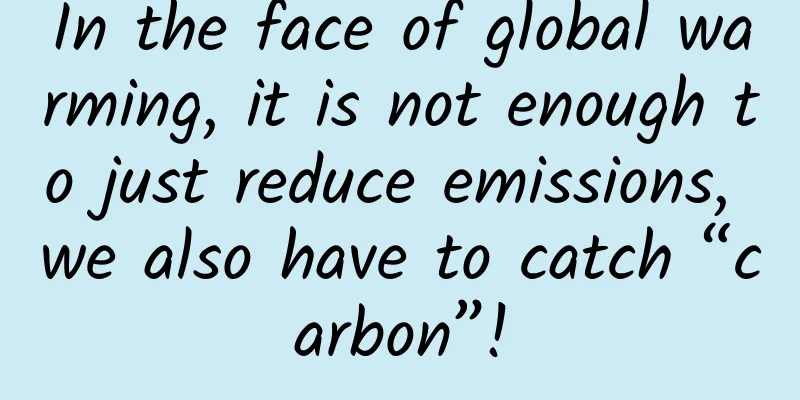In the face of global warming, it is not enough to just reduce emissions, we also have to catch “carbon”!

|
The world is really on the brink of danger. When it comes to nuclear war, no one wants it to happen. But if carbon dioxide emissions are not controlled, the global ecological situation in 80 years should be much worse than a nuclear war. Don't think 80 years is a long time, and it has nothing to do with me. That is something that my grandchildren need to prepare for. In fact, global warming is a threat that is approaching like a "grey rhino" and has a huge impact. Once it approaches, no method can reverse it. Even if human activities no longer release any ton of carbon dioxide into the atmosphere from now on, the global temperature will still rise according to the current inertia. This huge inertia will last for about 150-200 years. Then, nature will fix the extra carbon dioxide released since the industrial revolution back into the earth's crust and in the bodies of plants and animals through the carbon cycle. Therefore, without new technology, even though there are still 80 years, it is actually too late for us. Fortunately, since 2010, some carbon capture and collection technologies have begun to emerge. We can take carbon dioxide from the air back to the ground, which has given all mankind a glimmer of hope. Carbon capture technology is usually called "CCSU", and the last three letters stand for the capture, storage and reuse of carbon dioxide. This is also the order of maturity, and capture is the closest to maturity. In fact, carbon capture is not about filtering the air and pulling out the carbon dioxide in it. That is the least mature of all methods and the least likely to be implemented on a large scale. Because the content of carbon dioxide in the air is too low, less than 0.4 parts per million, it is not cost-effective to pick out something with such a low content from the air. It is a bit like digging holes in the desert to find water. It is estimated that you have to dig several holes before a few drops of water seep out, but the sweat you shed is much more than those few drops of water. Therefore, the most widely used carbon capture in the future is to capture carbon dioxide at the source of carbon dioxide emissions, that is, directly at the exhaust pipe. The carbon dioxide concentration here is at least 10%, which is much higher than the concentration of a few parts per million. The capture methods are mainly in three major directions: post-combustion capture, pre-combustion capture and oxygen-enriched combustion capture. Post-combustion capture, as the name implies, is to connect an absorption and separation device after the combustion chamber of fossil energy, and use some chemical methods to absorb carbon dioxide like a vacuum cleaner. This device can capture at least 90% of the carbon dioxide in the emission, and there is no need to do major surgery on the original factory, just add corresponding decarbonization equipment at the back end of the emission. But the disadvantage is that the energy consumption of capture is not low. 1/3 of the original output power of the power plant is used to capture carbon, and it also takes up a lot of space. Another way to capture carbon is to capture it before combustion, which is similar to the method of producing coal gas. Under the action of high-temperature water vapor, fossil fuels will gasify to produce carbon dioxide, carbon monoxide, methane, hydrogen, and nitrogen. All that can be burned will be used as fuel. The carbon dioxide that is separated first can be collected by capturing it in a liquid solution. Unfortunately, this technology is not suitable for traditional coal-fired power plants. It can only be used in new power plants and chemical plants, especially chemical plants that produce hydrogen. Finally, there is oxygen-enriched combustion. Simply put, how rich is oxygen? The oxygen content is about 95%. The advantage is high combustion efficiency, high concentration of carbon dioxide produced, and less pollution from nitrogen oxides. But the disadvantage is also very obvious. The combustion of oxygen at this concentration requires too high a furnace because the temperature rises a lot at once. We still have to build a factory from scratch. Even if the carbon dioxide is captured, it is only the first step in a long journey, because you still have to find a reliable way to store it. You can't put it in a tank. This is something that another technology needs to solve. |
<<: Are sugar substitutes the perfect "substitute" for sugar? Friends who love sweets, take a look!
Recommend
NIO receives investment from Tesla's largest external shareholder, with its share price rising 22%
On October 9, Scottish asset management company B...
Watch out for Fit and POLO, the all-new Ford Fiesta will be launched this year
In the automotive industry, Germany, the United S...
What will the future be like as the industry moves from functionalization to intelligentization?
Since the AI AlphaGo defeated Lee Sedol, the to...
After 9 years of waiting, WeChat night mode is finally here! Experience the new WeChat version
In the past, people liked to read for a while bef...
How to use the "expert" economy, which is more lethal than "Internet celebrities", to market products
Jiuzhilan Interview: A one-stop strategy for buil...
10 Steps to Becoming a Professional iOS Developer — From Scratch
[[137409]] Want to get a piece of the mobile deve...
Smart home: The battle over standards will leave corpses everywhere
Under the background of the new normal of the eco...
The "cold" war in the office: Girls are more likely to feel that the air conditioner is too cold
Review expert: Peng Guoqiu, deputy chief physicia...
Can you get syphilis by swimming in a public swimming pool? The truth is...
During the long holidays, many people will arrang...
Your Android app doesn’t need that many permissions
Android system permissions can be a bit confusing...
Why do women's underwear always have a bow on the front?
This article was reviewed by Yan Ya, PhD in Medic...
How is 360 mobile search advertising promotion charged and ranked?
How is mobile search promotion charged and ranked...
From the perspective of Android development, let’s talk about Airbnb’s Lottie!!!
1. Introduction Have you ever met some designers ...
What magical data are there on Double 11 this year?
One minute with the doctor, the postures are cons...
What kind of rubber band is this that can achieve great results with just a little effort?
Produced by: Science Popularization China Author:...









